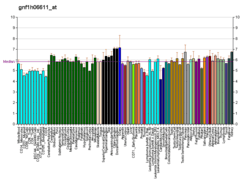Prokineticin receptor 1
Prokineticin receptor 1, also known as PKR1, is a human protein encoded by the PROKR1 gene.[4]
See also
References
External links
- "Prokineticin Receptors: PKR1". IUPHAR Database of Receptors and Ion Channels. International Union of Basic and Clinical Pharmacology.
Further reading
- Parker R, Liu M, Eyre HJ, et al. (2000). "Y-receptor-like genes GPR72 and GPR73: molecular cloning, genomic organisation and assignment to human chromosome 11q21.1 and 2p14 and mouse chromosome 9 and 6". Biochim. Biophys. Acta. 1491 (1–3): 369–75. doi:10.1016/s0167-4781(00)00023-3. PMID 10760605.
- Lin DC, Bullock CM, Ehlert FJ, et al. (2002). "Identification and molecular characterization of two closely related G protein-coupled receptors activated by prokineticins/endocrine gland vascular endothelial growth factor". J. Biol. Chem. 277 (22): 19276–80. doi:10.1074/jbc.M202139200. PMID 11886876.
- Masuda Y, Takatsu Y, Terao Y, et al. (2002). "Isolation and identification of EG-VEGF/prokineticins as cognate ligands for two orphan G-protein-coupled receptors". Biochem. Biophys. Res. Commun. 293 (1): 396–402. doi:10.1016/S0006-291X(02)00239-5. PMID 12054613.
- Soga T, Matsumoto S, Oda T, et al. (2003). "Molecular cloning and characterization of prokineticin receptors". Biochim. Biophys. Acta. 1579 (2–3): 173–9. doi:10.1016/S0167-4781(02)00546-8. PMID 12427552.
- Strausberg RL, Feingold EA, Grouse LH, et al. (2003). "Generation and initial analysis of more than 15,000 full-length human and mouse cDNA sequences". Proc. Natl. Acad. Sci. U.S.A. 99 (26): 16899–903. doi:10.1073/pnas.242603899. PMC 139241. PMID 12477932.
- Ota T, Suzuki Y, Nishikawa T, et al. (2004). "Complete sequencing and characterization of 21,243 full-length human cDNAs". Nat. Genet. 36 (1): 40–5. doi:10.1038/ng1285. PMID 14702039.
- Battersby S, Critchley HO, Morgan K, et al. (2004). "Expression and regulation of the prokineticins (endocrine gland-derived vascular endothelial growth factor and Bv8) and their receptors in the human endometrium across the menstrual cycle". J. Clin. Endocrinol. Metab. 89 (5): 2463–9. doi:10.1210/jc.2003-032012. PMID 15126578.
- Gerhard DS, Wagner L, Feingold EA, et al. (2004). "The status, quality, and expansion of the NIH full-length cDNA project: the Mammalian Gene Collection (MGC)". Genome Res. 14 (10B): 2121–7. doi:10.1101/gr.2596504. PMC 528928. PMID 15489334.
- Hillier LW, Graves TA, Fulton RS, et al. (2005). "Generation and annotation of the DNA sequences of human chromosomes 2 and 4". Nature. 434 (7034): 724–31. doi:10.1038/nature03466. PMID 15815621.
- Pasquali D, Rossi V, Staibano S, et al. (2006). "The endocrine-gland-derived vascular endothelial growth factor (EG-VEGF)/prokineticin 1 and 2 and receptor expression in human prostate: Up-regulation of EG-VEGF/prokineticin 1 with malignancy". Endocrinology. 147 (9): 4245–51. doi:10.1210/en.2006-0614. PMID 16763065.
This article is issued from
Wikipedia.
The text is licensed under Creative Commons - Attribution - Sharealike.
Additional terms may apply for the media files.



